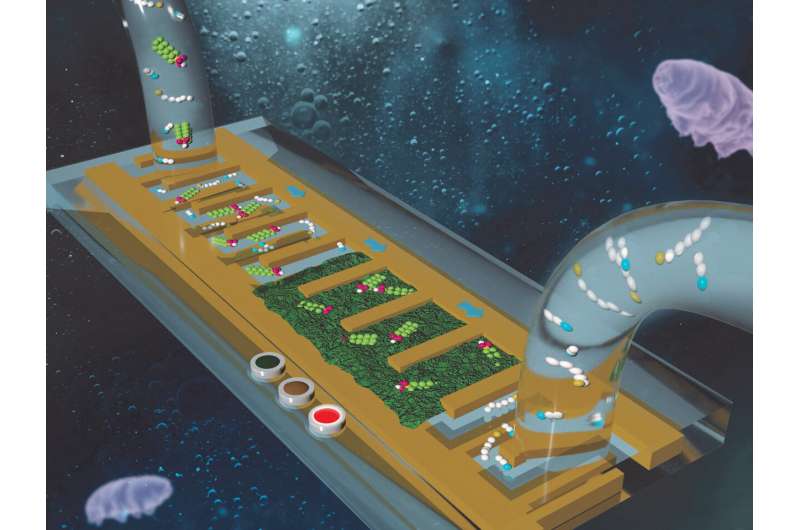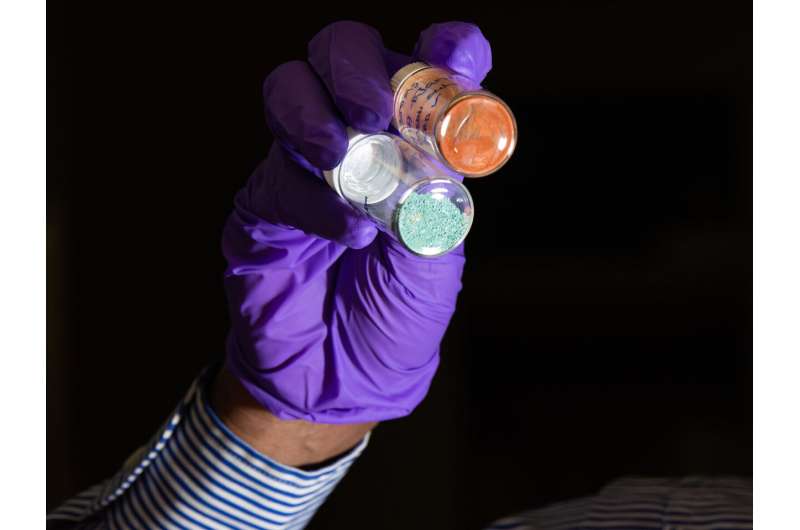An illustration of PNNL’s PFAS Sensor. Water samples flow in one end, through the maze and PFOS gets captured by a sponge-like material in the middle. The technology is available for licensing. Credit: Nathan Johnson | PNNL
PNNL has patented an accurate and portable way to detect miniscule amounts of an extremely persistent toxic chemical that accumulates in our bodies and our environment.
Per- and polyfluoroalkyl substances (PFAS) are hazardous, man-made chemicals used in products such as non-stick cookware, waterproof clothing, food packaging, and firefighting foam because they repel water and oils. They do not break down naturally and there is no known quick fix to destroy them. Multiple studies have linked PFAS—which stay in the environment a long time—to elevated cholesterol, obesity, weakened immune system, endocrine disruption, thyroid issues, and cancer.
The federal health advisory level for PFAS is 70 parts per trillion, roughly equal to a grain of salt in 1,000 gallons of water. Some U.S. states have even more stringent levels that are a fraction of that. The levels are so low, that water samples must be sent off to a laboratory for measurement using sensitive analytical methods. The difficulty of detecting and measuring PFAS presence quickly at the source makes remediation challenging.
PNNL researchers developed a small device to quickly and accurately measure perfluorooctanesulfonic acid (PFOS), which is a type of PFAS, with the New Jersey Institute of Technology (NJIT). The proprietary lab-on-a-chip sensor can detect PFOS levels that are two orders of magnitude lower than the federal health advisory—0.5 parts per trillion. This offers an unprecedented and convenient way to detect miniscule amounts of PFOS in water accurately, on-site, and in real time. The device is small enough, and performs fast enough, to provide point-of-use measurement data. Additionally, PNNL is expanding the device's capability to detect all kinds of PFAS contaminants.
"Clean water is essential. Being able to quickly identify sources of PFAS contamination is also essential," said Radha Motkuri, a PNNL materials scientist. "We envision a world where this lab-on-a-chip can be deployed immediately and broadly."
Lab-on-a-chip PFAS Sensor
Rapid, on-site detection of super-low levels of PFAS and PFOS is a key step to protecting human health. Historically, testing takes several hours to a few days—minimum. With PNNL's portable sensor, PFOS levels can be measured immediately on-site.
Metal-organic framework materials are analagous to a sponge, and were used to target captured PFOS on a small probe within a microfulidic plate. Credit: Andrea Starr| PNNL
"Last year, we worked on PFOS capture and we are continuing to develop materials that will capture additional PFAS molecules from water," said Motkuri. "But we wanted to develop a tool that can quickly and accurately quantify PFAS on-site."
The sensor looks like a microscope slide with a small maze zigzagging through it. Water samples flow through the maze and into a sponge-like material in the middle. Any PFOS or PFAS molecules in the water sample get captured by the sponge, while other molecules pass through.
As an electric current pulses through the sensor, the captured PFAS causes a change in the current. This change gives an instantaneous measurement of PFAS concentration in the sample.
Looking forward to less PFAS
PNNL's point-of-use sensor has the potential to be used for the detection of other disconcerting chemicals that threaten human health and the environment. The PNNL and NJIT team is working to extend this technology to detect other PFAS molecules—including PFOA, PFBA, PFBS, and GenX—in various sources of groundwater.
The PFAS Sensor is patent pending and the technology is available for licensing.
"A variety of different sectors could use this technology, including environmental remediation, municipal water, chemical manufacturing, petroleum, and defense," said Allan Tuan, PNNL commercialization manager. "This is an exciting breakthrough to quickly detect and measure PFOS and other contaminants."
The PFAS Sensor is the focus of "Metal–Organic Framework-Based Microfluidic Impedance Sensor Platform for Ultrasensitive Detection of Perfluorooctanesulfonate," a paper published in the March 4 edition of ACS Applied Materials & Interfaces.
More information: Yu H. Cheng et al. Metal–Organic Framework-Based Microfluidic Impedance Sensor Platform for Ultrasensitive Detection of Perfluorooctanesulfonate, ACS Applied Materials & Interfaces (2020). DOI: 10.1021/acsami.9b22445
Journal information: ACS Applied Materials and Interfaces
Provided by Pacific Northwest National Laboratory

























